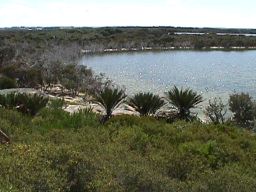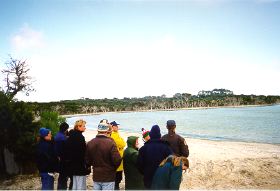
 |
Lake Warden System |
| Lake Warden System at a glance | |||
| Location: | immediately north of Esperance | ||
| Area: | 1200 hectares | ||
| Data selection | |||
| Index: | |||

Description
The site comprises (from west to east) Lake Warden, Racecourse Lake, Windabout Lake, Woody Lake and Wheatfield Lake in the Coramup Creek watercourse and Station Lake, Mullet Lake and Ewans Lake in the Bandy Creek watercourse.
Nearby wetlands: Pink Lake (ESP007WA) is one kilometre south-west, Mortijinup Lake (ESP006WA) is 18 kilometres west.
Landform: Mesoscale-macroscale ovoid or irregular lakes; microscale-mesoscale round or irregular sumplands.
Geological setting: Situated in the Albany-Fraser Orogen (gneiss, granite); in depressions within vegetated sand dunes (Warden to Wheatfield Lakes) and on a small coastal plain (Station to Ewans Lakes).
Climate: Median and mean annual rainfall at Esperance are 580 mm and 615 mm respectively, mostly falling in May-August; annual evaporation is about1800 mm.
Water supply: Inflow to Wheatfield Lake, and (in wetter years) through the system to Lake Warden, from Coramup Creek, originating 25 kilometres north; inflow to Ewans Lake, and in wetter years through to Mullet and Station Lakes and eventually the Southern Ocean, from Bandy Creek, originating 32 kilometres north. Also some inflow to Lake Warden from creeks originating 9 and 14 kilometres north north-west. Groundwater seeps into some of the lakes. All catchments are highly disturbed (cleared).
Inundation: Warden, Woody, Wheatfield and Mullet Lakes are permanent or occasionally dry out in autumn whereas all other wetlands are probably seasonal. During the 1980s, major flooding of the system occurred in 1984, 1986, 1989 and 1999.
Water depth: In Lake Warden the maximum was 2.9 metres in September 1989 while the September mean is 1.30 metres. Woody, Wheatfield and Mullet Lakes were usually about one metre deep in September in the 1980s. Most other wetlands usually were shallower.
Water salinity: Lake Warden was saturated in May 1982 but the salinity has been as low as 15 ppt in winter. The September mean is 59 ppt. It is less saline at Woody and Wheatfield Lakes. The wetlands probably were to some extent saline before clearance in the catchment.
Water pH: Lake Warden: 6.8-9.5.
Water colour: Clear.
Ecological role: In the national context, one of the most important sites for numbers of Hooded Plover Charadrius rubricollis; in the context of south-western Australia, a major dry season refuge for waterbirds.
Plant structural formations: At most lakes, low closed-forest or closed-scrub in periform arrangement (some of it dead, some rarely inundated); low shrubland (samphire) occurs extensively on the coastal plain (Bandy Creek watercourse). Surrounding areas support open-scrub or are cleared.
The site is a good example of a system of naturally-brackish/saline coastal lakes in the bioregion.
Notable flora:
Threatened Species: None.Composition: Melaleuca cuticularis forms the low forest; sedges (notably Baumea juncea, Juncus kraussii, Isolepis nodosa and Gahnia trifida) occur as understorey. In the eastern parts, Melaleuca preissiana occurs in the fringing tree zone and the samphire marsh includes Halosarcia pterygosperma, H. pergranulata and Sarcocornia blackiana. Suaeda australis occurs in spring-fed areas. Lake bed flora include Ruppia sp., Lamprothamnium papulosum and Nitella sp.
Notable fauna (waterbirds):
Threatened Species: Hooded Plover Charadrius rubricollis (Nv) occur on at least seven of the wetlands and breed, probably in most years, at Station Lake (e.g. 14 nests, November 1990); they probably also breed at Lake Warden. The highest number counted was 539 (national rank 1, regional rank 1) at Lake Warden in April 1988; other high counts have been 240 at Lake Warden and 99 at Station Lake. Freckled Duck Stictonetta naevosa (Sr)(up to 11) have been recorded twice (Woody & Wheatfield Lakes). Up to eight Recherche Cape Barren Goose Cereopsis novaehollandiae subsp. grisea (Nv) occurred at Windabout and Ewans Lakes in the 1980s.Composition: 65 species recorded in the system (39 at Ewans Lake, 37 at Lake Warden, 31-33 at other main lakes); 21 listed under treaties. The 65 includes five darters and cormorants, 13 ducks and allies, 25 shorebirds and six gulls and terns. Fairy Tern Sterna nereis periodically occur in small numbers at several of the wetlands. Pectoral Sandpiper Calidris melanotos (up to six) and Broad-billed Sandpiper Limicola falcinellus (one) have each been recorded twice at the site.
Breeding: Seven species found breeding in the system, generally one to two at most lakes except Wheatfield Lake (four species). Red-capped Plover Charadrius ruficapillus and White-faced Heron Ardea novaehollandiae each bred at three lakes, e.g. the former in four years at Lake Warden. Great Crested Grebe Podiceps cristatus bred in at least one year at Wheatfield Lake.
Moulting: Australian Shelducks Tadorna tadornoides probably moult in late spring at Lake Warden.
Migration Stop-over: 18 species of migrant shorebird occur in the system (mainly at Warden, Station and Ewans Lakes), six of them regularly. The most abundant species are Red-necked Stint Calidris ruficollis (700, March 1988) and Curlew Sandpiper C. ferruginea (230, February 1983).
Numbers: The highest number of waterbirds counted was 16 919 (regional rank 12) at Lake Warden in November 1982; the other lakes each support up to 1000-4000 except Windabout Lake (6775, May 1985). Up to c. 20 000 waterbirds use the site simultaneously (e.g. 19 129 over the whole system, May 1985), and more than 10 000 occur annually. The site supports more than 1% of the national populations of Hooded Plover and Banded Stilt (up to 10 000, September 1982, Lake Warden, regional rank 5). The most abundant species in the system are Banded Stilt, Australian Shelduck (5500, November 1982, regional rank 9) and Black Swan (3500, November 1982, regional rank 2), all at Lake Warden, and Grey Teal (5500, May 1985) at Windabout Lake. The site is also regionally significant for Chestnut Teal (400, regional rank 8), Musk Duck (360, rank 7), Greenshank (153, rank 5), Great Knot (100, rank 3) and Whiskered Tern (100, rank 4).
Notable fauna (Other taxa):
Threatened Species: None.Composition: A species of mullet (Aldrichetta sp.) sometimes enters the lakes on the Bandy Creek watercourse. Juvenile fishes, possibly Hardyhead Atherinosoma sp. or mullet, were abundant in Lake Warden in February 1993. Shells of the gastropod Coxiella striata form deposits at the margins of Lake Warden. 15 other invertebrates have been recorded from the system: Five protozoans, one nematode, one amphipod, three ostracods, one foraminiferan Peneroplis, and four insects (two Diptera, two Coleoptera).
 Social and cultural values:
Social and cultural values:
Education: The site has potential for education of students, residents and tourists on ecology of waterbirds (notably Hooded Plover) and saline lakes.Research: By WADCALM (ongoing wetland monitoring), RAOU (total of 264 waterbird surveys in the system) and RAOU/WADCALM (waterfowl surveys, 1986-91).
Recreation: Windabout Lake is regularly used for sailing and Woody Lake for water-skiing. Aesthetics: Viewed from higher country to the north (e.g. main road from Kalgoorlie), the system is a major component of the spectacular Esperance landscape of lakes, beaches, granite hills, islands and ocean.
Land tenure & Land Use
Land tenure:
On site: Apart from the south part of Windabout Lake, the system is contained within Nature Reserves 32257, 15231 and 23825.Surrounding area: No information.
Current land use:
On site: Nature conservation and recreation.Surrounding area: Pasture grazing, rural smallholdings, urban (residential and light industrial), recreation (golf course, racecourse), small airfield and high human population. Some parts of the system have a buffer of native vegetation more than 100 m wide; the buffer is more than 1 kilometre wide in the south-east (Reserve 23825).
Disturbances or threats
Current: Eutrophication (agricultural fertilisers) and excessive human disturbance (use of vehicles and horses on dry lake margins). Windabout and Woody Lakes are sometimes used for water-skiing; this may exclude some waterbirds from those lakes but alternative waterbird refuges exist on the other lakes.
Potential: Salinisation.
Conservation measures taken
Listed under the Ramsar Convention. The site is included on the Register of the National Estate.
Management authority and jurisdiction
The reserves are managed by WADCALM for NPNCA. District office located at Esperance.
South Coast Regional Land and Water Care Strategy: The Esperance-Sandplain Sub-region. Prepared by: the South Coast Regional Assessment Panel and the South Coast Regional Initiative Planning Team, February 1997.